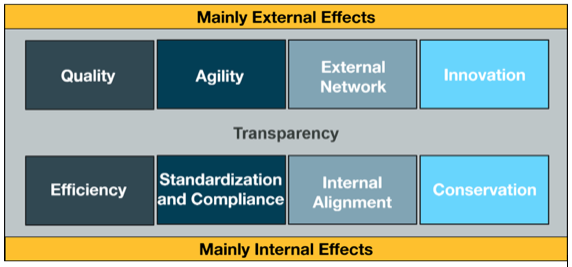Today, static business models can not keep pace with change. Ever shifting factors from demographic changes, capital availability and legal regulations to technological innovations and all present digitalization, mean that companies require a management approach that fits this volatile environment.
To execute strategy systematically and deal proactively with our digital world, organizations must understand how and when to modify or enhance their business processes. They need to know which processes are best candidates for intervention, and how to move rapidly from strategy to execution.
By Peter Franz and Dr Mathias Kirchmer, co-founders of BPM-D
Managing processes for strategy execution demands a robust and detailed management discipline which is why we have developed the Business Process Management-Discipline (BPM-Discipline) for strategy execution in a digital world. The BPM-Discipline is implemented through the “process of process management” (PoPM) and enables organizations to deal with change successfully, drive their growth agenda and create immediate and lasting competitive advantage.
Existing approaches to BPM usually focus on one or very few aspects of process management, e.g. implementing a process automation engine or setting up an enterprise architecture. However, we believe there is a need for a comprehensive overarching approach to identify and establish all process management components required to form a simple but successful BPM-Discipline in the context of a specific organization.
BPM as a management discipline
For many year’s practitioners questioned the value of BPM, but in the last five to seven years this situation has changed. Now most organizational leaders have begun to understand the value proposition and the broader dimension of BPM; the challenge has become how to establish BPM in an organization in a pragmatic but systematic way with minimal up-front investment.
To resolve this issue, we can look at other management disciplines and how they are implemented. For example, the discipline of Human Resources is introduced into an organization through the appropriate HR processes, like the hiring process, performance evaluation or promotion process. Similarly, you can implement a BPM-Discipline through the “process of process management”, the BPM process. You address the BPM-Discipline just like any other management discipline. If you interpret the BPM-Discipline as process itself, you can apply all the process management approaches, methods and tools to it – enabling an efficient and effective approach. The process of process management (PoPM) operationalizes the concept of the BPM-Discipline. It applies the principles of BPM to itself.
Creating transparency and delivering value
Research involving over 90 organizations around the world of different sizes and in different industries has stated that the transparency BPM brings is a key result. One the one hand, transparency is a value by itself; a clear view of organisational processes enables fast and well-informed decisions which are crucial for the success of a company. On the other hand BPM and the transparency it provides also helps to achieve other key values and enables the efficient management of the trade-offs between those values.
BPM-D identifies four key “value-pairs”:
- Quality and Efficiency
- Agility and Standardization (Compliance)
- External Networks and Internal Alignment
- Innovation and Conservation.
This is best illustrated by an example. A company wants to improve its call centre process. It identifies that only a few sub-processes are really relevant for clients to the extent that they have a willingness to pay a service fee for them. So, you improve these sub-processes focused on “quality” aspects. Other sub-processes are more administrative; clients don’t really care about them but they are important and need to be executed well. Hence the prime focus on these processes is on “efficiency” (mainly cost or time) aspects, using appropriate BPM approaches.
BPM creates the transparency required to achieve both values resulting in the highest quality where it matters and the best efficiency where this counts most. BPM helps to identify where it is really worth thinking of process innovation and where you can conserve existing good practices. Since an organization only competes with 15-20% of its processes, it is key to identify where innovation pays off. This is again possible though the transparency BPM delivers.
The values BPM delivers are shown below (Kirchmer, Franz, 2013).

An engine for strategy execution
The BPM-D framework enables organizations to establish a value-driven BPM-Discipline efficiently and effectively. Through the process of process management organizations are able to create an end-to-end “value network” around the existing organizational structure.
The combination of the framework and the PoPM implementation results in a value driven management discipline which transfers strategy into people and technology based execution – at pace with certainty, using the opportunities of our digital world.
The process of process management – and how it can be implemented through the BPM-Discipline – is fully explored in a White Paper published by Dr Mathias Kirchmer and Peter Franz at BPM-D in July 2015. You can sign up to receive a copy of this White Paper here
(1)Kirchmer, Lehmann, Rosemann, zur Muehlen, Laengle, 2013 and Franz, Kirchmer, Rosemann, 2011



Comments
It’s a rapidly changing world, and the challenge to keep up and more important stay ahead of the curve get’s more difficult every year.